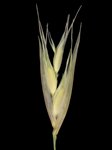
T. basitricha spikelet.
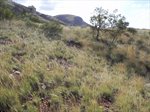
T. basitricha habitat.

T. basitricha orifice and sheath.
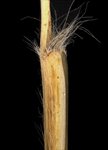
T. basitricha sheath; note hairs on the sheath surface.
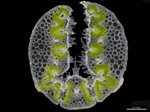
T. basitricha leaf section.
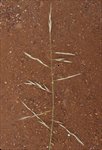
T. basitricha inflorescence.
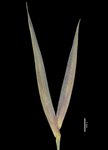
T. basitricha glumes.
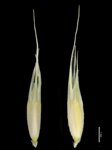
basitricha lemmas.

T. basitricha lemma bases.
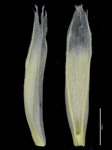
T. basitricha paleas.

T. basitricha map.
Name
Triodia basitricha M.D.Barrett
Citation
Nuytsia 26:71–73 (2015)
Derivation
basitricha — from the (transliterated) Greek basis, base, and trichos, hair, in reference to the hairy leaf sheaths.Common name
Pilbara Curly Spinifex
Synonyms
Triodia sp. Millstream (A.A. Mitchell PRP 207)
Diagnostic features
Foliage non-resinous to moderately resinous; leaf sheath surfaces with sparse to moderately dense hairs; leaf blades epistomatous (soft-type); lower glume narrowly lanceolate, L:W>5, 10–12.5 mm long; lemmas 3-awned, bitextured, the lower part uniformly covered with ±appressed hairs; callus acute but not sharply pungent, <0.5 mm long; palea bitextured, hairy; on rocky or gravelly slopes of mountains or low hills.
Habitat
Occurs on rocky and gravelly slopes of mountains or low hills.
Distribution and frequency
Endemic to the Pilbara and surrounds. Very patchily distributed throughout the Chichester and western Hamersley sub-regions, with an isolated occurrence in the Barlee Range south of the Pilbara. Very patchy throughout most of its range, but locally extensive north of Tom Price, in the vicinity of Brockman mines and Coolawanyah Station.
Similar species
Triodia basitricha belongs to the Soft group, sharing the epistomatous (soft-type) leaf blades.
The combination of epistomatous (soft-type) leaves and presence of hairs on the surfaces of the leaf sheaths is found only in a few other species: T. karijini, T. pisoliticola and T. veniciae. Amongst these, only T. basitricha has bitextured lemmas at maturity.
Several other species share with T. basitricha the awned, bitextured lemmas: T. degreyensis, T. avenoides, T. sp. Mt Ella, and T. schinzii. Triodia basitricha is the only one of these species with (sparse to moderately dense) hairs on the leaf sheath surface. Triodia avenoides and T. schinzii have a sharply pungent callus 0.8–1.5 mm long (0.2–0.5 mm long and blunt to acute and usually not sharply pungent in the remaining species). Triodia sp. Mt Ella is always strongly resinous (non-resinous to weakly resinous in T. basitricha). Triodia degreyensis has longer glumes (12.4–17 mm long) than T. basitricha (10–12.5 mm long).Conservation status
Priority Three.
Identification without florets
Only three other species share a combination of epistomatous (soft-type) leaves and hairy leaf sheath surfaces, T. karijini, T. veniciae, and T. pisoliticola. None of these species are known to occur within the distribution of T. basitricha s.s., however both T. basitricha and T. veniciae occur in the eastern Chichester sub-region, and might possibly co-occur. Triodia basitricha has longer lower glumes 10–12.5 mm long (5.4–8.5 mm long in T. veniciae) and 4–5 spikelets on longest basal branches (7–14 in T. veniciae).
Variation
The leaf sheath surfaces are variably hairy, from very sparse to moderately dense.
A population from near Pannawonica (P.J. Davidson 2026, CANB) lacks hairs on the surface of the leaf sheaths, and are genetically close to T. basitricha. The taxonomic status of these plants remains to be determined, and it is not treated in the key.
Notes
Triodia basitricha was mapped under T. melvillei and T. schinzii by Lazarides (1997), Lazarides et al. (2005) and Ausgrass (Sharp & Simon, 2002; Simon & Alonso, 2014), but their descriptions did not cover T. basitricha.
A full description of T. basitricha can be found in Barrett & Barrett (2015).